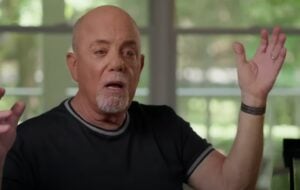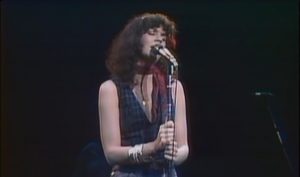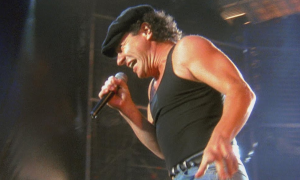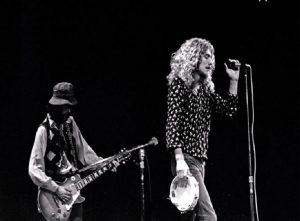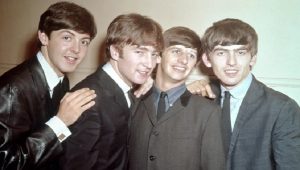The Iconic Guitars Rock Legends Play
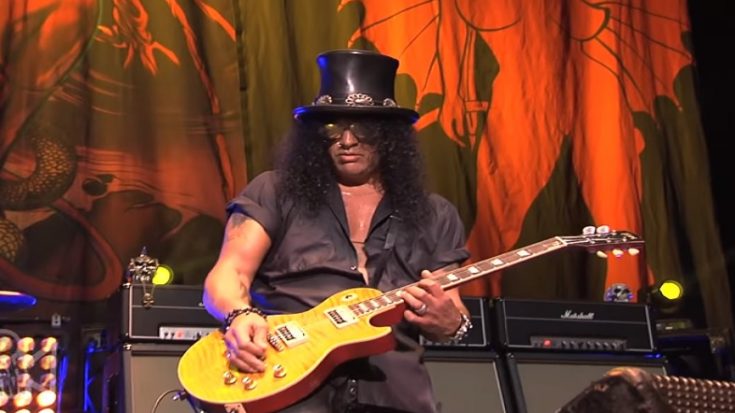
Slash - Moshcam /YouTube
It’s true that many iconic guitarists have a signature model or a favorite type of guitar that becomes closely associated with their image and sound. Let’s take a closer look at some of the mentioned guitarists and their preferred instruments:
While some virtuosos amass expansive collections, many find solace in a particular model that becomes an extension of their musical identity. Take Slash, for instance, whose image is as inseparable from his iconic top hat as it is from the Gibson Les Paul he wields.
This sentiment is echoed across the genre; whether it’s Eddie Van Halen and his self-built “Frankenstein,” Brian May’s handcrafted “Red Special,” or Jimmy Page’s dual allegiance to the Gibson Les Paul and the distinctive Danelectro 3021. Each guitarist’s chosen instrument is more than just a tool – it’s a symbol of their sonic signature.
These guitars not only served as tools for these musicians but also became iconic symbols of their respective styles and contributions to rock and metal music. The choice of a particular guitar is often deeply connected to the artist’s playing style, sound preferences, and overall aesthetic.
Slash’ Gibson Les Paul
Throughout his illustrious career, Slash has showcased a myriad of Les Paul guitars, each adorned in different colors. The one he loved to wield was known as the “Appetite Burst” Gibson Les Paul Standard, paying homage to the instrument used during the recording of Guns N’ Roses’ seminal album, Appetite for Destruction.
Reflecting on his early days in a video special with Gibson, the rock icon reminisced about his initial guitar purchase – a Gibson Explorer, driven by its affordability. However, this was merely a temporary preference, as he eventually swapped it for a Les Paul and has stuck with it ever since.
“I just thought it looked cool, I guess: the aesthetics of it. I knew that Jimmy Page [had] a Les Paul, which I thought looked cool, way before I ever actually picked up a guitar,” Slash revealed in an interview with Far Out Magazine.
James Hetfield’s Gibson Explorer
In a revealing interview, Metallica frontman James Hetfield shared that his first foray into the world of guitars involved a Gibson SG. However, despite this early connection, he has become widely recognized for his affinity towards either an Explorer or a Flying V.
In explaining his preference for the Explorer, Hetfield explained, “For me, this shape really fits me well. It was my back-up guitar for quite a while, the Explorer shape, and then it kind of quickly took over the V. I just wanted a really nice looking, different kind of guitar, and I love the shape.”
As Hetfield’s musical journey progressed, his collaboration with ESP marked a significant chapter. Together, they refined and personalized the Explorer model to create the Snakebyte, a distinctive iteration tailored to Hetfield’s exacting specifications.
https://twitter.com/DY3RS3V3/status/1368628441713623042
Dimebag Darrell’s Dean ML
Pantera’s iconic guitarist Dimebag Darrell was frequently seen wielding Dean ML guitars, and his initial encounter with this distinctive instrument was as memorable as it was serendipitous.
Gifted by his father in a striking cherry burst finish, Darrell’s first Dean ML came into his possession at the age of 16. The fortuitous timing of this gift coincided with his victory in a local guitar contest, where, intriguingly, the prize was another Dean ML guitar.
While Dimebag Darrell experimented with various Dean and Washburn guitars over the years, particularly during Washburn’s inactive period, it was unmistakably the blue “Dean From Hell” ML that emerged as his favored instrument. This iconic guitar, prominently featured on the cover of Pantera’s major label debut, became synonymous with Dimebag’s distinctive style and remained his instrument of choice.
Eddie Van Halen’s Frankenstrat
Eddie Van Halen possessed a unique ability to make any guitar sound exceptional, yet his renowned signature instrument was the Frankenstrat. Crafted by the maestro himself in the mid-’70s, this legendary guitar emerged from a fusion of a Fender Stratocaster and Gibson pickups.
In an interview with Guitar World, Van Halen shed light on his creative process, explaining, “What I was trying to do was cross-pollenate a Gibson with a Fender, because I love the vibrato bar. I didn’t have the money, and the guitar I wanted to play didn’t exist. It was that simple.”
Despite its humble origins, the Frankenstrat has transcended its maker’s workshop to be replicated by various manufacturers. Fender, in acknowledgment of the instrument’s impact, eventually introduced its own EVH line, drawing inspiration from the guitars and gear that defined Eddie Van Halen’s groundbreaking sound.
https://twitter.com/HlGHDEMAND/status/1232116840798867461
Tony Iommi’s Gibson SG
As documented by Guitar Player, Tony Iommi’s acquired his first guitar way before the formation of Black Sabbath and involved a Watkins model. However, upon the establishment of Sabbath, Iommi initially wielded a Fender Stratocaster before making a pivotal shift to a Gibson SG just before the recording of their debut album in 1970.
The transition to the SG was prompted by an incident during one of the band’s live performances when a pickup on his Fender malfunctioned. Having a Gibson on standby as an “emergency” guitar, Iommi discovered it to be more playable, particularly considering a past factory accident that resulted in the partial loss of his fingertips.
Reflecting on his affinity for the SG, Iommi shared with Gibson TV, “For me, I like it because I like the weight of them and it’s a comfortable guitar to play, I think. You know, I’ve been so used to the SGs all these years and it’s been great,”
Jimmy Page’s Gibson EDS-1275
Let’s begin by acknowledging that while the Gibson Les Paul held the esteemed position of being Jimmy Page’s preferred guitar, he occasionally utilized a Fender Telecaster early in his career.
However, another instrument that Page notably popularized was the Gibson EDS-1275, a double-neck guitar with a resemblance to the SG. Despite the Les Paul’s widespread favor among guitarists, it was undoubtedly EDS-1275 that deserved the spotlight due to it looking a lot cooler (just look at photos of Page sporting the double-neck).
Page shed light on the decision to incorporate the double-neck guitar during the recording of “Stairway to Heaven” in a 1985 interview at Les Paul’s house. He explained, “We recorded “Stairway to Heaven”, and because there was like so many guitars on it… it needed more texture than just one guitar. And a double neck seemed a perfect compromise, really, on it. So I ordered one from Gibson, and it was just after that point we’d recorded “Stairway”.”
Tom Morello’s Fender Stratocaster
During his tenure with Rage Against the Machine, Tom Morello predominantly favored a Fender Telecaster or his custom “Arm the Homeless” guitar. The latter was crafted for him in Hollywood during the mid-’80s, a period when financial constraints were a reality, as revealed in an interview with Music Radar.
Detailing the origins of the “Arm the Homeless” guitar, Morello recalled its initial shortcomings, describing it as aesthetically unpleasing, sonically subpar, and excessively priced. After numerous alterations, Morello reached a point of resignation, acknowledging in his own words, “I gave up and said, ‘Okay, it’s never going to sound like what I hear in my head, so I’m going to stop worrying and fucking around, and I’m just going to play music.’ Just to make it clear — I wasn’t happy with where the guitar was at, but I settled.”
In a subsequent evolution of his musical journey, Morello transitioned to a Fender Stratocaster upon the formation of Audioslave. The introduction of the “Soul Power” guitar, as he referred to it in Guitar World, signified not only a change in equipment but a renaissance in his artistic expression and the pursuit of a distinctive musical path.
Kurt Cobain’s Fender Mustang
Kurt Cobain, renowned for his penchant for smashing guitars during live performances, had a distinct fondness for the Fender Mustang when he wasn’t engaging in such destructive acts. According to an interview with Guitar World, Cobain revealed that he only possessed two of these guitars, a preference driven by his left-handed orientation and a quest for affordability.
In describing the Fender Mustang, the late Nirvana frontman didn’t mince words about its drawbacks. He characterized it as both economical and inefficient, highlighting its less-than-ideal sound quality and diminutive size. Cobain also critiqued its tuning stability, noting that when adjustments were needed, the process involved a cumbersome procedure of loosening all the strings and removing the bridge.
“You have to turn these little screws with your fingers and hope that you’ve estimated it right. If you screw up, you have to repeat the process over and over until you get it right. Whoever invented that guitar was a dork,” a frustrated Cobain revealed.
Dave Mustaine’s Flying V
Dave Mustaine of Megadeth has been a longstanding devotee of the Flying V guitar, leading to collaborative partnerships with multiple guitar manufacturers to create his customized versions.
Notably, these collaborations have extended across various brands such as Gibson, Epiphone, Dean, Jackson, and Kramer. What sets Mustaine’s modified Flying V apart is the incorporation of an Explorer headstock, presenting a distinctive deviation from the conventional Flying V design.
In an interview with Sweetwater, Mustaine articulated the rationale behind his customized instrument, “I play both rhythm and lead guitar, so I wanted a guitar that was able to play both. I didn’t want a lead guitar that all of a sudden got fat, no, I want one that is skinny and that sounds fat.”
Jimi Hendrix’s Fender Stratocaster
Jimi Hendrix, a trailblazer in the realm of rock ‘n’ roll, stands as one of the pioneering guitar heroes. His groundbreaking playing techniques have made its mark in history, serving as a profound influence for successive generations of guitarists.
Central to Hendrix’s musical legacy is the Fender Stratocaster, the instrument with which he carved his distinctive sound. Expressing his perspective on the various guitar models in an interview with the L.A. Free Press, Hendrix challenged the prevailing preferences for guitars of different ages.
The guitar virtuoso shared, “Everyone’s screaming about the 7-year-old Telecaster, and the 13-year-old Gibson and the 92-year-old Les Paul. They’ve gone into an age bag right now, but it’s nothing but a fad. The guitars nowadays play just as good. The Stratocaster is the best all around guitar for the stuff we’re doing.”
Nancy Wilson’s Fender Telecaster
Nancy Wilson readily acknowledges that, for a significant portion of her time with Heart, her go-to instrument was an acoustic guitar. However, she transitioned to playing more electric guitar in the ’80s, expanding the band’s sonic palette.
“When I joined Heart, I sort of brought the more acoustic element into the band, and then from there I expanded on to electric. And electric rhythm playing, mainly – not so much lead necessarily. If you could make an analogy, I’d be more of a Neil Young as an acoustic guitar player and a Pete Townshend as an electric player,” she shared with Guitar World.
While playing the iconic opening riff in “Barracuda” on a Gibson SG showcased her electric prowess, Wilson revealed her favorite guitar is her blue Fender Telecaster. Describing it as an old ’60s model, she emphasized its significance as her preferred stage guitar, one that accompanies her at every performance.
https://twitter.com/LegendsonTeles/status/777134349783293952
Brian May’s Red Special
Prior to assuming the role of guitarist for the iconic rock band Queen, Brian May, in his teenage years, had created his own guitar alongside his father. This homemade instrument, famously known as “The Red Special”, became an integral part of May’s musical journey, featuring prominently in his extensive career.
In an interview with Absolute Radio, May candidly shared the reason why he DIY’d “The Red Special”, revealing “Really, it happened because I couldn’t afford a guitar.”
The instrument took shape from materials readily available in their home, representing not just a solution born out of necessity but an extraordinary manifestation of craftsmanship and resourcefulness.
Angus Young’s Gibson SG
Angus Young of AC/DC has expressed his preference for the SG over the Les Paul, citing a straightforward reason—the Les Paul’s considerable weight. If you’re as short as the diminutive devil-horned dynamite of hard rock, you can probably empathize with the potential discomfort of playing a Les Paul for an extended two-hour show, anticipating soreness in the shoulders.
Expressing his preference for the SGs, Young elaborated in a 1984 interview with Guitar World, citing their lightweight construction as a key factor. In contrast, he found Fenders to be too heavy and lacking the robustness he sought.
“I liked the SGs because they were light. I tried Fenders but they were too heavy and they just didn’t have the balls. And I didn’t want to put on them DiMarzios because then everyone sounds the same. It’s like you’re listening to the guy down the street. And I liked the hard sound of the Gibson,” Young emphasized.
Dave Grohl’s Gibson ES-335
During his time as Nirvana’s drummer, Dave Grohl stumbled upon his favored guitar, a Gibson ES-335, to be precise, a 1967 Gibson Trini Lopez ES-335. However, it was when he transitioned to touring with Foo Fighters following Nirvana’s dissolution that this particular guitar evolved into his unmistakable signature instrument.
In a 2022 interview with NME, Grohl emphasized the paramount role this guitar played in shaping the Foo Fighters’ sound. He revealed, “This f**king thing – this is the sound of the Foo Fighters, this guitar. On every record, I might use other guitars every now and then. For the most part, it’s just this.”
While the Nicest Guy in Rock has dabbled with other models like Explorers and Les Pauls, it is the ES-335 that he is most closely associated with and has, in fact, introduced his own version, solidifying its status as his quintessential instrument.




